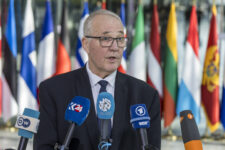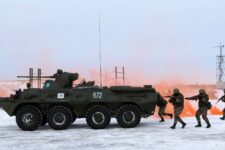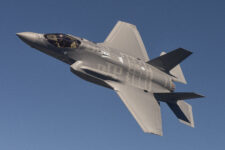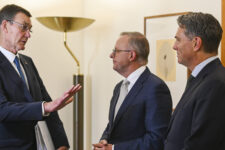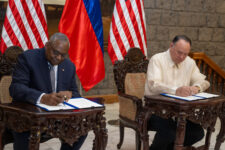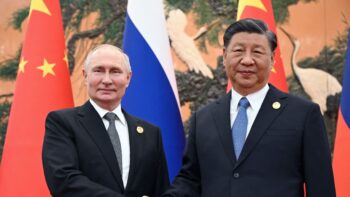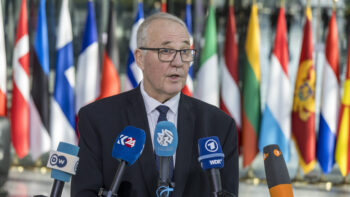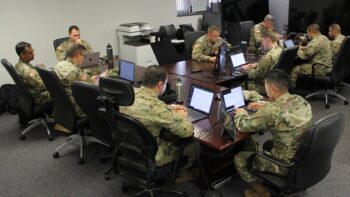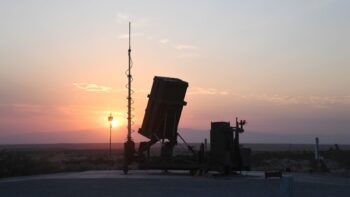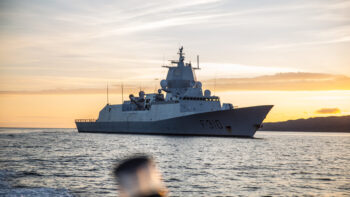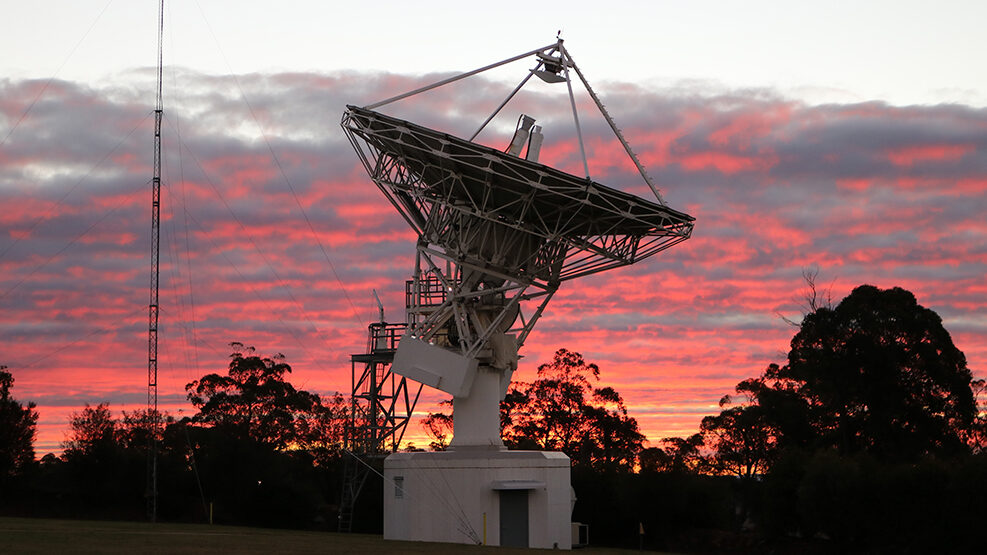
This Lockheed satellite station near Armadale, NSW, is used for tracking, telemetry and control for a range of customers. (Lockheed Martin)
CANBERRA: A recent solicitation released by the Australian government under the uninspiring title of JP 9102 may not have caught much attention in the US, but it should: despite the plain name, the solicitation represents a major step forward in what is expected to be a $4 billion AUS ($2.86 billon) commitment to Australia’s first sovereign military satellite program.
Industry sources say the Jan. 11 tender will lead to at least two, and as many as four, military communication satellites being built for the Australian military. A decision on the winner is expected this year, with the contract all encompassing of ground stations, launch and life cycle costs. Not included in the package are the buildings to house the yet-unknown number of ground stations; as space experts note, those buildings can be crucial to a program’s success because of the complex wiring, shielding and security requirements.
Getting the system up and running as quickly as possible is important for Canberra. The Australian Defence Force does have other defense satellite communication options today, but they are not robust. It owns a communications payload aboard an Optus C-1 satellite, which it is nearing the end of its projected operational life; the military also bought access to 20 channels on Intelsat IS-22, a deal that runs out in 2024. (It does have access to the Boeing-built WGS defense constellation, having paid to build one of the satellites.)
The lack of details on the ground station requirement is particularly notable for several reasons. First, Australia and BAE Systems struggled to build the first WGS ground stations, with the system coming in years late and over budget (not unusual for space systems). Second, Australia discovered the limits of access to WGS during the recent massive bushfires. The Aussies asked the US military for WGS coverage to help with command and control; US Army Pacific turned things around in 24 hours, but that was time lost and highlighted the limits of Australia’s access even during a time of peace, when American assets were available.
RELATED: Allies eyeing ‘niche’ space capabilities for warfighting with US
One issue to keep an eye on as the program spins up: as this is the first sovereign military communications satellite system, the Australian Defence Force simply does not have many people trained in flying, managing and fighting satellite systems. One industry source here believes that will be the most challenging aspect of JP 9102 — building a large enough cadre of military and civilians to make and keep the constellation useful. Military satcom requires large groups of people in control rooms to make them work; Australia will need at least several hundred highly trained people, this source believes.
Another challenge will come as Australia deploys systems such as the MQ-4C Triton, MQ-9B SkyGuardian, and MC-55A Peregrines, modified Gulfstream 550s which boast advanced sensors and communications equipment. Those platforms generate huge amounts of data, and it all must be shared security and at speed.
Add to that the ambitious effort here to build a much more joint command and control system, somewhat akin to America’s Joint All Domain Command and Control (JADC2), and the importance of WGS grows clearer. The relatively small Australian military (89,000 active and reserve) has launched Projects Jericho (Royal Australian Air Force), Pelorus (Royal Australian Navy), and Beersheba (Royal Australian Army) to improve joint performance and information sharing, and the new 9102 system will be a key enabler.
Which companies are competing for this unprecedented Australian space investment? Here’s a rundown:
Airbus is offering something based on its Skynet system, built for the British military. This system includes ground stations, buildings and satellites and is provided on a service contract to the UK and to other partners.
“Team Maier” includes global giant Microsoft; Willyama, an IT and cyber security company which also provides support to the Australian Department of Defence; engineering and utilities provider UGL Limited; and satellite technology manufacturer Blacktree Technology. In its releases, Airbus stresses putting Australian organizations at “the forefront” and “transferring knowledge from international partners.”
In one of the more uniquely Australian twists to a defense competition, this team is named with a Torres Strait islander word. And the release on the team creation includes this quote: “Airbus thanks the Meriam people of the Eastern Islands of the Torres Strait for permission to use their language in the naming of our JP9102 Industry Team, and pays respect to their Elders, past and present.” Paying respect to Aboriginal and Torres Strait islanders is often the first thing done at a government or corporate event here, and a clear corporate signaling that Airbus is trying to brand its effort as a uniquely Australian venture.
A linguisitic study of the word offers this explanation: “To the Meriam Mir people of Mer (Murray Island) in the eastern Torres Strait, bright meteors are an important element of death customs and beliefs. We draw from a combination of ethno-historic studies and interviews with Meriam elders to understand the role of bright meteors (Maier) in Torres Strait traditions relating to spiritual elements of death rites using a framework of symbolic anthropology. We find that bright meteors serve as symbolic representations of death and mortuary purification practices and show how the physical properties of meteors are incorporated in ritual, belief, spirituality, and custom.”
Boeing Australia views itself as the incumbent because of its experience with WGS, and will offer an upgraded version of WGS.
The American aerospace giant has teamed with Saber Astronautics, a Sydney-based artificial intelligence and machine-learning company, to develop technology that predicts the impact of unexpected events and space weather on spacecraft. It is also working with Clearbox Systems, a Sydney-based software development and integration provider.
Leidos will provide cyber, security and network integration services and software development environments and cyber test ranges. ViaSat is doing work to develop and standardize the modem and waveform “used for JP 9102’s high capacity data circuits,” per a release. Titomic will work on producing “sustainable ‘green’ titanium for the production of space components.”
Finally, Boeing is pledged to work with the Indigenous Defence and Infrastructure Consortium to “find opportunities for Indigenous-owned and -controlled businesses on JP9102 by aligning discrete work packages to their capabilities as well as supporting capability growth.”
Lockheed Martin Australia has experience as the prime for the AEHF secure satellite communications network which the Australian Defence Force can use, thanks to an international agreement. Their solution has been optimised for data throughput, geographic coverage and survivability against counterspace threats. Like the other competitors, it is teaming with a wide array of Australian companies.
Blacktree Technology, an Australian owned communications solutions specialist, “will primarily support the Lockheed Martin Australia narrowband MILSATCOM ground segment.” Meanwhile, DXC Technology, a leading global IT services company, will handle “development of ground and control segment cybersecurity architectures, including interfaces with existing hardware and external software elements.”
Lockheed has also listed a number of smaller local firms, including agreements with Linfox, Conscia, Av-Comm, Calytrix Technologies, EM Solutions, Shoal Group, Clearbox Systems, STEM Punks and Ronson Gears.
Northrop Grumman Australia is teaming with Inmarsat, the US-based satellite communications company. It’s also working with.L3Harris Technologies, which will “provide in-country, ground station capability including the Australian Wide Multi-Band Terminal (WMBT), pronounced WOMBAT, delivering exponential growth in capability and upgradeability over existing systems, while occupying the same ground footprint.”
Finally, Optus, which is best known here as a mobile phone carrier but it also is Australia’s largest satellite operator. They’ve teamed with Raytheon Australia and Thales Australia in a joint bid on the project, with Mitsubishi Electric also part of the team.
As their release on JP 9102 notes: “Since 1985, Optus has been Australia’s preeminent satellite provider, launching 10 satellites, operating 13 spacecraft, and providing support to over 100 international space programs. Since 2003, Optus has flown the C1 Satellite — which provides critical mission capabilities for Defence’s operations and, at the time of launch, was the world’s largest Defence-civilian spacecraft.
“Optus currently flies 7 satellites — including NBN’s 2 Skymuster Satellites, with plans to deploy software-defined satellite Optus 11 in 2023 for Australia and New Zealand, making Optus the first satellite operator in Asia Pacific to launch a software-defined satellite that can provide both flexible concurrent broadcast and broadband services via a very high throughput satellite (VHTS) design.”

